|
For the past 100 or so years, pistol
manufacturers have been trying to dethrone the .45 ACP as the
king of the fighting pistol cartridges. They have introduced
shorter, longer, fatter, thinner, lighter, heavier, slower, and
faster handgun cartridges, but the .45 ACP is more popular now
than ever. New pistols chambered for the ancient cartridge are
introduced every year to shooters, both in the traditional 1911
pattern, or some variation thereof, or in the newest high-tech
plastic design. The .45 keeps plugging along.
When I was a kid, I used to carry around in my
pocket everyday, everywhere, a Federal Cartridge Company
ballistic chart. I loved those little charts that Federal used
to give away. I spent a lot of time studying the little pocket
chart. One of the least impressive cartridges to me was the .45
ACP. There were modern, flat-shooting magnums listed on that
little chart, and the ballistics of the .45 ACP seemed anemic in
comparison. I saw little need for the .45 ACP when I could buy a
good .357 or .44 Magnum revolver for half the price of a 1911 Colt
Government Model. Why that cartridge and gun had not been
discontinued decades earlier was a mystery to me. I was an
ignorant kid.
I was almost twenty years old before I got a
real hankering for a 1911 .45 pistol. I spent many hours
scouring the Brownell’s catalog looking at parts to
customize a 1911, and as many hours reading all that I could
about custom pistolsmiths like Armand Swenson and Frank
Pachmayr. Back in those days, one fully expected to spend as
much money customizing and tuning a new 1911 as he spent for the
basic Colt pistol. Today we have it pretty good. You can walk
into any self-respecting gun shop and walk out with a 1911
pistol that is equipped with everything that it needs to be a
good fighting or target pistol right out of the box. Also, the
.45 ACP cartridge is no longer just loaded with a 230 grain
round-nosed bullet, but is available with any configuration of
high-tech hollowpoint, flatnose, or pre-fragmented projectile
that one could imagine. In other words, regardless of my
youthful uninformed opinion, the .45 ACP has always been a good
fighting cartridge, and today is even better. The improvements
made in recent decades to upgrade smaller bullets to the degree
that they perform as well as did the .45, has also been applied
to the .45 ACP cartridge, making it still the preferred
cartridge of professionals. There are many good choices of
caliber for a defensive pistol, but it is hard to argue with the
success of the good old forty-five.
Just as it is hard to beat a .45, it is also
foolish to argue against the longevity of the 1911 design. I
cannot count, nor will I attempt to, the number of manufacturers
around the world that are producing a 1911 style pistol. There
are many good choices on the market, and one of them is the
subject of this piece; the High Standard Crusader Compact.
The Crusader Compact is a well-built defensive handgun with
forged steel parts and quality assembly. The pistol is of the
“Officer’s Model” size, having a shorter butt and wearing
a 3.65 inch barrel. The Crusader Compact is finished in a
business-like matte Parkerized finish. It has a bushingless
slide with a coned barrel for a good slide to barrel fit. It has
a single spring over a steel guide rod recoil spring system.
This model of the High Standard 1911 pistol is available only
through Lipsey’s, a distributor in Baton Rouge,
Louisiana. What makes this compact 1911 special is that despite
its low price, Lipsey’s has had the gun built loaded up with
features that usually are found only on pistols that carry a
much higher price tag. This is no stripped-down basic pistol.
The Crusader Compact has an excellent set of steel Novak-style
combat sights that are very easy to see, and offer a good sight
picture for target work. They are dovetailed into the slide, and
the rear sight has a set screw to loosen to make windage
adjustments. Another feature usually found only on more
expensive pistols is the beavertail grip safety and skeletonized
Commander-style hammer. The feed ramp is polished, and the
barrel is throated to feed hollowpoint ammunition. The trigger
is a good-looking partially skeletonized unit, with a crisp
trigger pull that feels lighter than its measured five and
one-half pounds. The short magazine still holds seven rounds,
for a loaded capacity of eight, and has a base pad for positive
insertion into the slightly beveled magazine well. The best
feature of this little 1911 is, to me, the extended ambidextrous
safety. Even today, many high-dollar 1911 pistols do not come
with an ambidextrous safety. The safety on the Crusader Compact
is well-designed, and is securely held in place with the slotted
pin method, instead of relying upon the right-hand grip panel to
hold the safety in place. The grip panels are of the fully
checkered wood pattern, and offer a secure grip. The mainspring
housing is flat and serrated.
Shooting the Crusader Compact for function and
accuracy was done using several types of ammunition from exotic
specialty rounds to high performance hollowpoints to target
handloads. During the first two magazines of ammo, I had two Cor-Bon
hollowpoints hang up on the feed ramp, but after that the pistol
ran perfectly through many different varieties of hollowpoint
ammunition, including those same Cor-Bon loads. The gun ran
smoothly with everything, until late on the third day of
shooting, it started to balk on my target handloads, not fully
chambering. This had me puzzled, as the gun had previously fired
many of that same handload without hesitation. Stripping it
down, I found that as the gun got dry and filthy, its tight
extractor was hanging onto the chewed-up rims of my overly-used
brass cases. Some of these cases I have shot until the headstamp
is no longer legible, and the crusader’s tight extractor was
too tight with those old cases. Anyway, not counting those two
early cartridges, the gun ran perfectly with good commercial
ammunition, and when clean, also ran perfectly with my
handloads. I wish that I could say that about all new 1911
pistols. There are some high-dollar pistols on the market for
which the manufacturer recommends a generous break-in period.
This inexpensive Crusader Compact runs quick and slick, as can
be seen in the video. It was very easy to control in rapid fire
shooting, and the gun shot to the sights for me at twenty-five
yards with most combat ammunition. After the accuracy testing
using the Ransom Rest, I
plinked at numerous targets on my range such as swinging steel
and small rocks, and the sights were very easy to use and
properly adjusted. Accuracy with most of the high performance
combat ammo was between the two and one-half to three inch range
at twenty-five yards, and my target handloads performed very
well, grouping consistently around two inches, with the best and
worst groups fired pictured here. The Crusader Compact was a
very consistent performer.
I fired several different types of ammunition
for velocity from the short barrel. Velocity readings were
recorded using a PACT Professional chronograph at ten
feet from the muzzle, with the results listed in the chart
below. Temperature was around the seventy five degree Fahrenheit
mark, with low humidity at an elevation of approximately four
hundred feet. JHP is jacketed hollowpoint. EPR is a specialty
high performance type bullet loaded by Extreme
Shock. SWC is a handloaded lead semi-wadcutter bullet.
DPX is the Barnes all-copper hollowpoint bullet loaded by
Cor-Bon. PB is a specialty hollowpoint bullet with a nylon ball
nose loaded by Cor-Bon, called PowRBall.
Velocities are listed in feet-per-second. Bullet weights are
listed in grains.
| Ammunition |
Bullet Weight |
Velocity |
| Buffalo Bore JHP |
185 |
1054.6 |
| Buffalo Bore JHP |
200 |
1078.9 |
| Cor-Bon JHP |
230 |
876.7 |
| Cor-Bon JHP |
200 |
930.4 |
| Cor-Bon JHP |
185 |
1156.8 |
| Cor-Bon PB |
165 |
1097.7 |
| Cor-Bon DPX |
185 |
1028.9 |
| Extreme Shock EPR |
185 |
945.9 |
| Handload SWC |
200 |
811.4 |
Even from the short barrel of the Crusader
Compact, the ammunition posted respectable velocities, and all were
easily controllable, partially due to the 35.6 ounce weight of
the all-steel pistol. I carried the Crusader Compact on my hip
in a Fobus paddle holster, which carried the pistol high
and tight. It rode comfortably in that position. The size of the
Crusader Compact is not much larger, but it is heavier, than a
lightweight J-frame S&W revolver. Both are excellent
concealed carry guns, but the High Standard needs a good holster
to carry well. It is a bit heavy for pocket carry, but you get
eight shots of .45 ACP compared to five shots of .38 Special
with the pocket revolver, so it is a good trade.
The High Standard Crusader Compact .45 is a
dandy pistol. It compares in features and quality with other
pistols costing almost twice as much. I usually do not list
suggested retail prices in my reviews, as these reviews stay
posted for years, and prices change. Also, street prices are
usually much lower than suggested retail. However, the price of
this Crusader Compact, along with the list of features, makes
this pistol a particularly good value. The suggested retail
price of this pistol as of this writing is only $555. You can
probably find one available for $500 or less. That is an
extremely good value for a 1911 Compact .45 tricked out as this
one is. As mentioned earlier, Lipsey’s is the only distributor
carrying this pistol, but your dealer can get one you. Have him
to call 1-800-666-1333, or to find a Lipsey’s dealer near you,
click on the DEALER FINDER at www.lipseys.com.
To order the high performance ammunition listed
here, go to www.buffalobore.com,
www.corbon.com,
or www.extremeshock.com.
Jeff Quinn
| For a list of dealers where you can
buy this gun, go to: |
 |
|
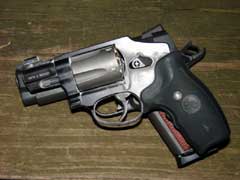
Size compares favorably to lightweight five-shot
.38 Special.
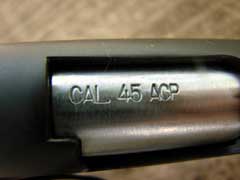
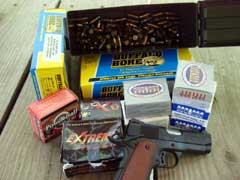
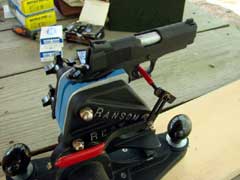
Author tested the Crusader Compact for function
and accuracy using a variety of ammunition types.
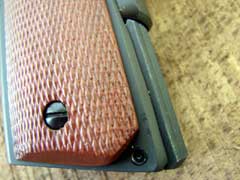


Smallest and largest groups fired using Jeff's
favorite target handload.

Seven-yard offhand rapid-fire group using Cor-Bon
PowRBall.
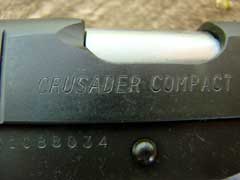
|
  
Got something to say about this article? Want to agree (or
disagree) with it? Click the following link to go to the GUNBlast Feedback Page.
|
Click pictures for a larger version.
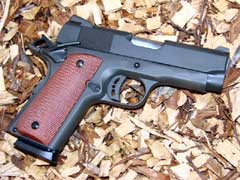
High Standard Crusader Compact 1911 .45 ACP auto pistol.

Gun comes with one magazine and a hard plastic case.
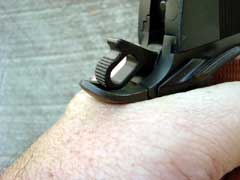
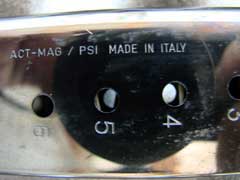
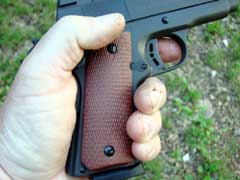
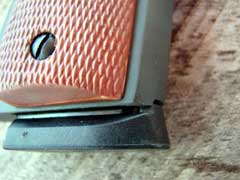
Magazine holds seven shots and sports an extended base
pad.
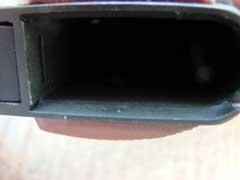
Magazine well is beveled for easy insertion.
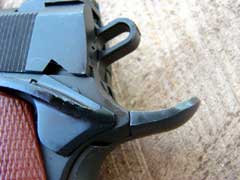
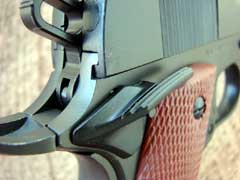
Ambidextrous safety makes the Crusader Compact work
easily in either hand.

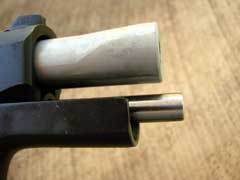
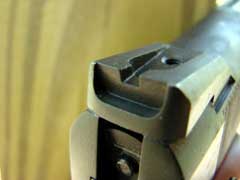
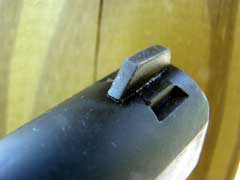
Sights are excellent, and of the type you would expect
to find on a much more expensive weapon.
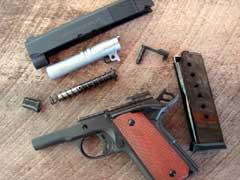
Pistol strips easily without tools.
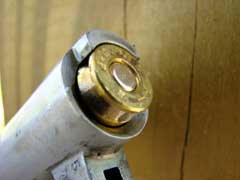
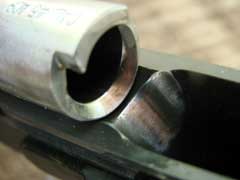
Feed ramp is polished and barrel is throated to feed
hollowpoint ammunition.
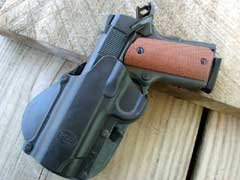
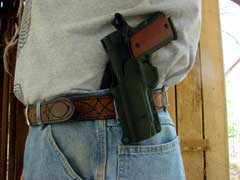
Gun carries well in an inexpensive Fobus holster.
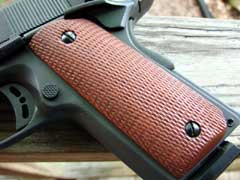

Checkered wood grips.
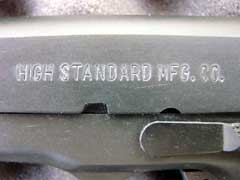
|
![]()